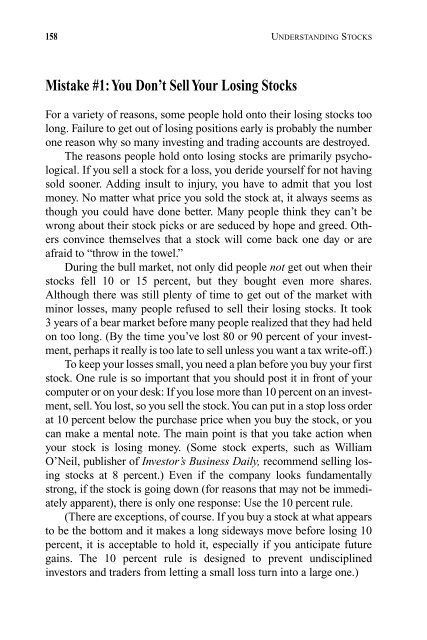Understanding Stocks
Understanding Stocks
Understanding Stocks
Create successful ePaper yourself
Turn your PDF publications into a flip-book with our unique Google optimized e-Paper software.
158 UNDERSTANDING STOCKS<br />
Mistake #1:You Don’t Sell Your Losing <strong>Stocks</strong><br />
For a variety of reasons, some people hold onto their losing stocks too<br />
long. Failure to get out of losing positions early is probably the number<br />
one reason why so many investing and trading accounts are destroyed.<br />
The reasons people hold onto losing stocks are primarily psychological.<br />
If you sell a stock for a loss, you deride yourself for not having<br />
sold sooner. Adding insult to injury, you have to admit that you lost<br />
money. No matter what price you sold the stock at, it always seems as<br />
though you could have done better. Many people think they can’t be<br />
wrong about their stock picks or are seduced by hope and greed. Others<br />
convince themselves that a stock will come back one day or are<br />
afraid to “throw in the towel.”<br />
During the bull market, not only did people not get out when their<br />
stocks fell 10 or 15 percent, but they bought even more shares.<br />
Although there was still plenty of time to get out of the market with<br />
minor losses, many people refused to sell their losing stocks. It took<br />
3 years of a bear market before many people realized that they had held<br />
on too long. (By the time you’ve lost 80 or 90 percent of your investment,<br />
perhaps it really is too late to sell unless you want a tax write-off.)<br />
To keep your losses small, you need a plan before you buy your first<br />
stock. One rule is so important that you should post it in front of your<br />
computer or on your desk: If you lose more than 10 percent on an investment,<br />
sell. You lost, so you sell the stock. You can put in a stop loss order<br />
at 10 percent below the purchase price when you buy the stock, or you<br />
can make a mental note. The main point is that you take action when<br />
your stock is losing money. (Some stock experts, such as William<br />
O’Neil, publisher of Investor’s Business Daily, recommend selling losing<br />
stocks at 8 percent.) Even if the company looks fundamentally<br />
strong, if the stock is going down (for reasons that may not be immediately<br />
apparent), there is only one response: Use the 10 percent rule.<br />
(There are exceptions, of course. If you buy a stock at what appears<br />
to be the bottom and it makes a long sideways move before losing 10<br />
percent, it is acceptable to hold it, especially if you anticipate future<br />
gains. The 10 percent rule is designed to prevent undisciplined<br />
investors and traders from letting a small loss turn into a large one.)

















